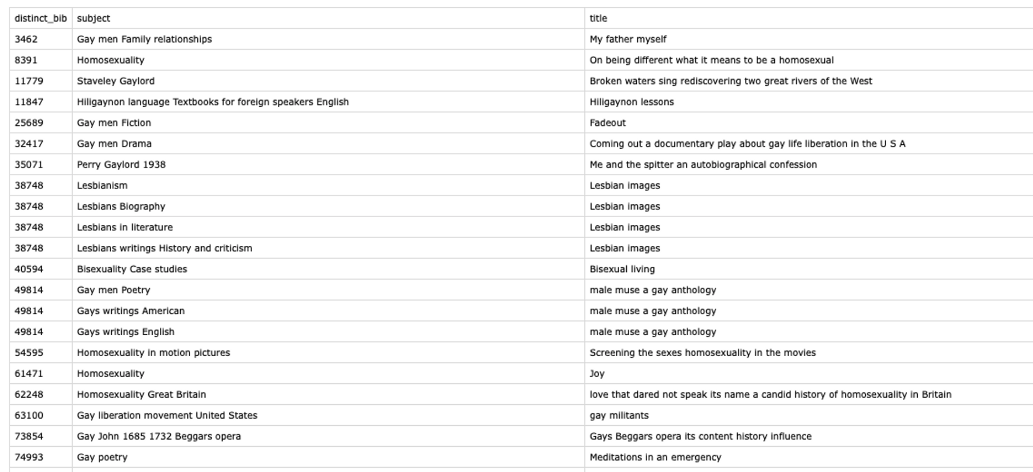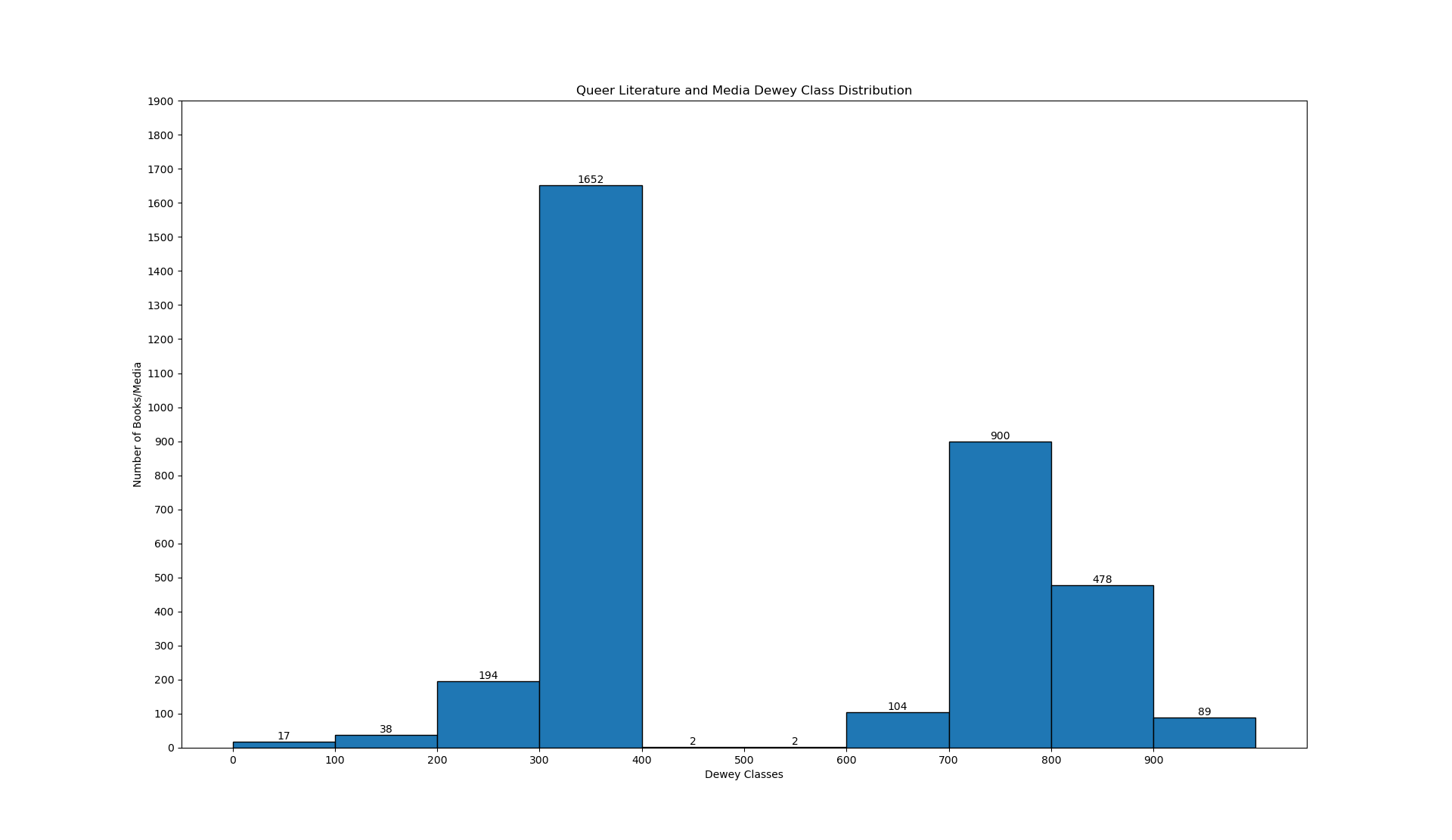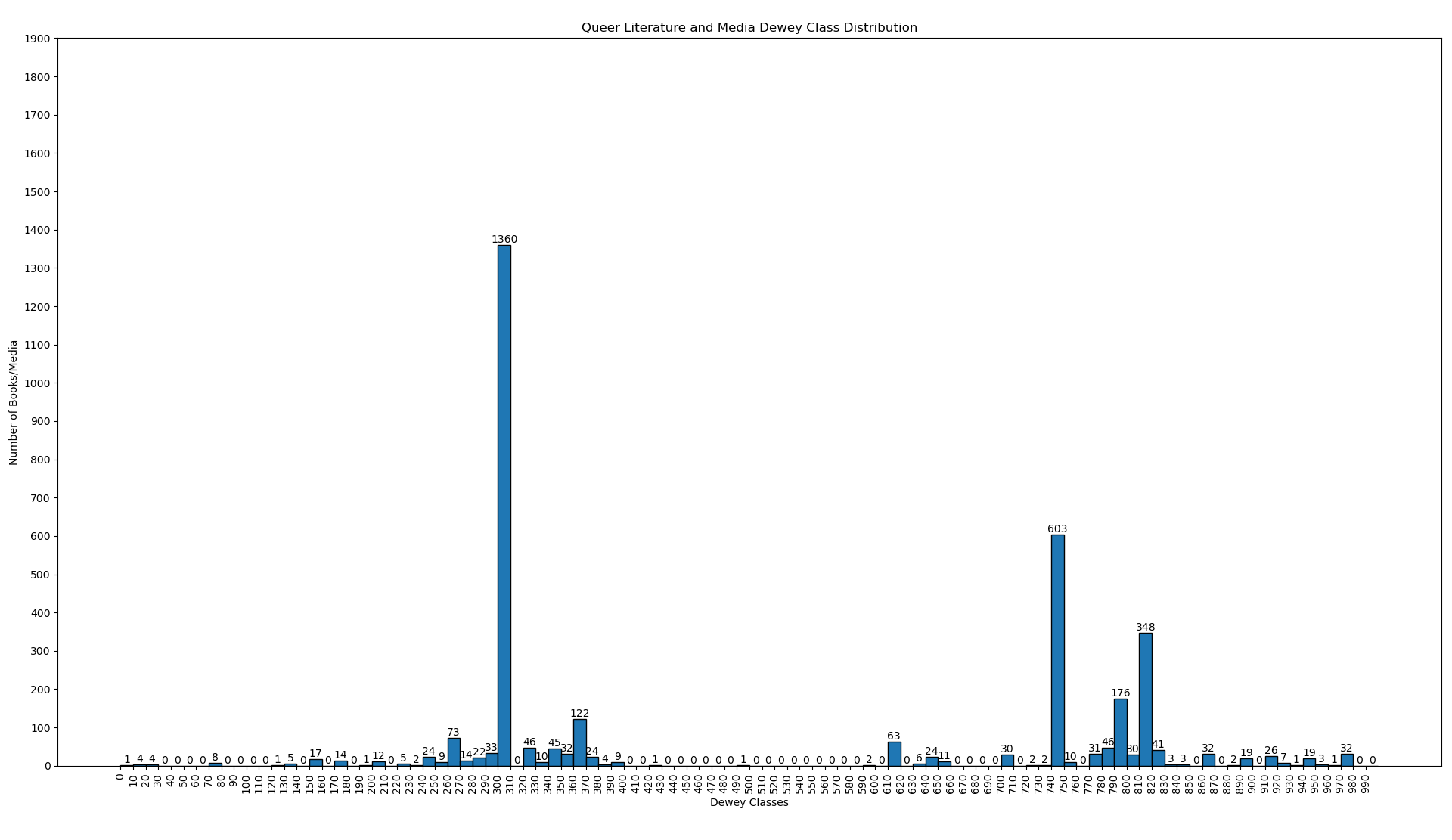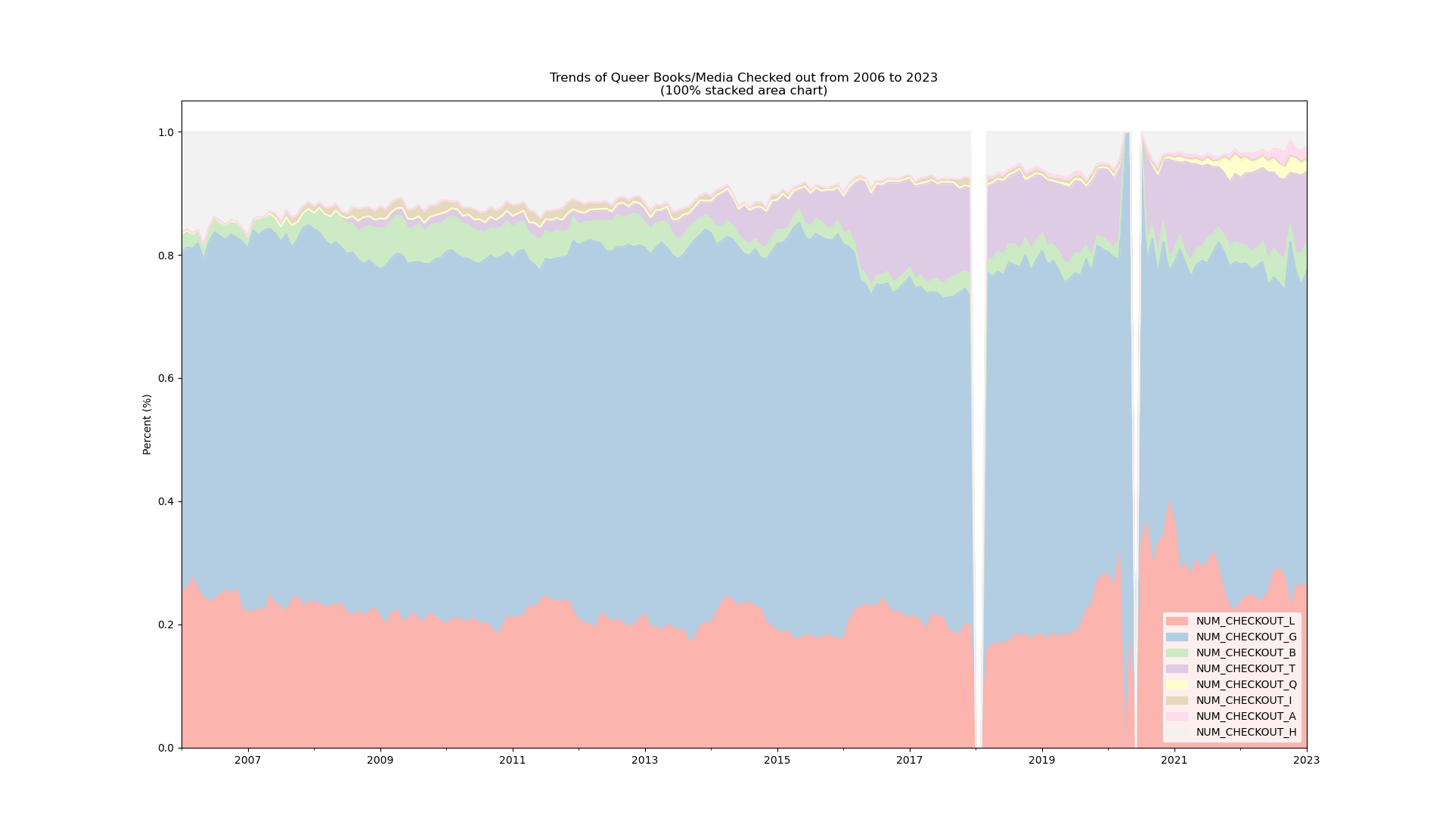Dewey Classifications and Trends of LGBTQ+ books in the SPL
MAT 259, 2023
Yanchen Lu
Concept
This project is an exploration of books and media regarding LGBTQ topics in the Seattle Public Library, how they are represented and categorized by the library, as well as how the public’s interest in them have changed throughout the years.
As a bisexual person growing up, I always felt that queer literature and media were limited or insufficiently represented compared to other subjects. Access to these resources is an important way for both members of the LGBTQ community and people outside of it to learn about, understand, and accept these marginalized identities and come to appreciate queer sub-cultures. Fortunately, as more countries decriminalized and/or legalize same-sex marriage, and as (western/US) culture shifts to become more accepting of the LGBTQ community, I've seen more and more authors and creators advocate for queer representation in literature and media. Therefore, I set out to investigate what types of queer books/media can the public access from the Seattle Public Library, and how has the public’s interest in them has grown and shifted.
As a bisexual person growing up, I always felt that queer literature and media were limited or insufficiently represented compared to other subjects. Access to these resources is an important way for both members of the LGBTQ community and people outside of it to learn about, understand, and accept these marginalized identities and come to appreciate queer sub-cultures. Fortunately, as more countries decriminalized and/or legalize same-sex marriage, and as (western/US) culture shifts to become more accepting of the LGBTQ community, I've seen more and more authors and creators advocate for queer representation in literature and media. Therefore, I set out to investigate what types of queer books/media can the public access from the Seattle Public Library, and how has the public’s interest in them has grown and shifted.
Query
I selected distinct titles that have a Dewey Classification, to see what these works are classified as.
Unfortunately, there is a non-negligible amount of books/media not categorized in the Dewey Classes, which may cause the distribution to be skewed.
For example, the query for the checkout data for books/media on the bisexual subject as follows:
SELECT DISTINCT(title), deweyClass
FROM (
SELECT *
FROM(
SELECT DISTINCT(bibNumber) AS distinct_bib, subject
FROM
spl_2016.subject
WHERE
spl_2016.subject.subject LIKE '%homosexual%'
OR spl_2016.subject.subject LIKE '%lesbian%'
OR spl_2016.subject.subject LIKE '%gay%'
OR spl_2016.subject.subject LIKE '%bisexual%'
OR spl_2016.subject.subject LIKE '%transgender%'
OR spl_2016.subject.subject LIKE '%queer%'
OR spl_2016.subject.subject LIKE '%intersex%'
OR spl_2016.subject.subject LIKE '%asexual%'
ORDER BY bibNumber
) bib_subj
INNER JOIN (
SELECT title, itemtype, deweyClass, bibNumber as out_bib
FROM
spl_2016.outraw
WHERE deweyClass != ''
)outraw_titles
ON distinct_bib = out_bib
)inner_join_table
ORDER BY deweyClass;
For example, the query for the checkout data for books/media on the bisexual subject as follows:
SELECT
YEAR(cout) AS YR, MONTH(cout) AS MO, COUNT(cout) AS NUM_CHECKOUT
FROM(
SELECT *
FROM(
SELECT DISTINCT(bibNumber) AS distinct_bib, subject
FROM
spl_2016.subject
WHERE
spl_2016.subject.subject LIKE '%bisexual%'
ORDER BY bibNumber
) bib_subj
INNER JOIN (
SELECT title, itemtype, deweyClass, bibNumber as out_bib, cout
FROM
spl_2016.outraw
)outraw_titles
ON distinct_bib = out_bib
) inner_join_table
GROUP BY YR, MO;
Preliminary sketches
While I wasn’t able to avoid all irrelevancy and errors in the produced book/media collection, when I manually check the CSV file, it didn’t look like they were a majority or would drastically affect data aggregation.
It’s interesting to see that each book is often assigned multiple subjects. From the dataset, it seems that these subjects are often related and overlap with each other.
This is part of the reason why I decided to work with queer books/media that are already categorized into Dewey Classes.

It’s interesting to see that each book is often assigned multiple subjects. From the dataset, it seems that these subjects are often related and overlap with each other.
This is part of the reason why I decided to work with queer books/media that are already categorized into Dewey Classes.

Process
One of the issues with my queried data is that those entries without a Dewey Class are unfortunately discarded from the dataset, which can skew distribution.
The generated distribution bar chart revealed significant representation in the 300 Dewey classes, specifically Social Sciences, Sociology and Anthropology classes. The next two most significant categories include the 700-800 classes on Arts and Recreation, and the 800-900 classes on Literature.

Queer books/media is most represented in the 300-400 categories (Social Sciences).
The next most popular are the 700-800 (Arts and recreation) categories.

Let's take a finer look, the 300-310 Social sciences, sociology and anthropology categories are the most represented, with 1360 entries.
The next categories are 740-750 Graphic arts and decorative arts, and 810-820 American literature in English.
The generated distribution bar chart revealed significant representation in the 300 Dewey classes, specifically Social Sciences, Sociology and Anthropology classes. The next two most significant categories include the 700-800 classes on Arts and Recreation, and the 800-900 classes on Literature.

Queer books/media is most represented in the 300-400 categories (Social Sciences).
The next most popular are the 700-800 (Arts and recreation) categories.

Let's take a finer look, the 300-310 Social sciences, sociology and anthropology categories are the most represented, with 1360 entries.
The next categories are 740-750 Graphic arts and decorative arts, and 810-820 American literature in English.
Final result
Lastly, the aggregated checkout records over the years showed an overall upward trend of increased checkout records of all queer books and media. I’ve separated into 8 subgroups, each letter in the LGBTQIA acronym as a subgroup, plus the broader ‘homosexuality’ subgroup. While most subgroups experience smaller increase in checkouts, there are two notable subgroups: the ‘transgender’ subgroup and the ‘homosexuality’ subgroup.
Since early 2013, checkout records of books/media on transgender subjects have experienced a more significant increase compare to other subgroups, suggesting the topic gaining more public interest. On the contrary, checkout records gradually decreased for the ‘homosexual’ subgroup over the two decades, as the usage of the word as a broad category of sexual and gender minorities falls out of favor.
Apart from the 5 months of missing data in 2020 due to COVID-19, I’ve also found that in the early months of 2018, the SPL database had extremely low to no checkout records from any of the subgroups of books/media of queer subjects.

The stack area chart shows the overall trend of public interest in queer literature and media.

The 100% stacked area chart reveals relative trend differences between subgroups more clearly.
Notably, interests in transgender and queer subjects increased, interests in homosexual and intersex subjects decreased, and a general trend of diversification of interests in LGBTQ+ literature and media.
Overall, I think the data from Seattle Public Library reflected attitudes toward and interests in LGBTQ identities and the community rather accurately. The checkout records reveals increasing public interest in learning about the LGBTQ community, which may lead to more acceptance in our society. The data also validated that the increase in positive queer legislation, advocacy, and discourse in recent years was able to help diversity queer identities gain more recognition and acknowledgement.
Since early 2013, checkout records of books/media on transgender subjects have experienced a more significant increase compare to other subgroups, suggesting the topic gaining more public interest. On the contrary, checkout records gradually decreased for the ‘homosexual’ subgroup over the two decades, as the usage of the word as a broad category of sexual and gender minorities falls out of favor.
Apart from the 5 months of missing data in 2020 due to COVID-19, I’ve also found that in the early months of 2018, the SPL database had extremely low to no checkout records from any of the subgroups of books/media of queer subjects.

The stack area chart shows the overall trend of public interest in queer literature and media.

The 100% stacked area chart reveals relative trend differences between subgroups more clearly.
Notably, interests in transgender and queer subjects increased, interests in homosexual and intersex subjects decreased, and a general trend of diversification of interests in LGBTQ+ literature and media.
Overall, I think the data from Seattle Public Library reflected attitudes toward and interests in LGBTQ identities and the community rather accurately. The checkout records reveals increasing public interest in learning about the LGBTQ community, which may lead to more acceptance in our society. The data also validated that the increase in positive queer legislation, advocacy, and discourse in recent years was able to help diversity queer identities gain more recognition and acknowledgement.
Code